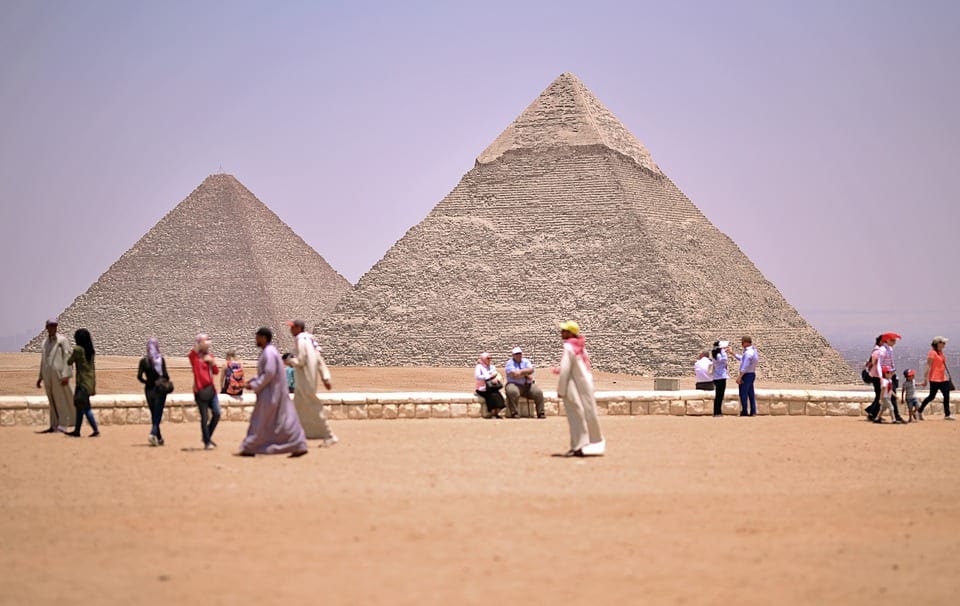Share this!
5 Facts That Make The Pyramids Even More Amazing To Visit
The Pyramids of Giza are truly among the world’s most incredible wonders. Rich with history, steeped in mystery, and structurally miraculous even to this day, they’re unlike any other attractions in the world, and undoubtedly account for a great deal of international tourism to Cairo and the surrounding areas. Making the pyramids even more fascinating is the fact that the more you learn about them, the more interesting they become. They’re not underwhelming in person, and it doesn’t take away from their mystique to find out more about them. With that in mind, we wanted to write up five facts that make them even more extraordinary to visit, should you ever get the chance to do so.

1. The World’s Tallest Building For 3,871 Years
Most of us tend to think of the pyramids as being massive, but not particularly tall by comparison to some other structures around the world. For much of human history, however, perception would have been different. According to one article, the Great Pyramid held the record for world’s tallest structure from 2560BC-1311AD – a period of 3,871 years. The same article notes that the Lighthouse of Alexandria may have briefly eclipsed the Great Pyramid in 280 BC, but its height is not known for sure, and it didn’t last. So we can safely say that the largest of the Giza pyramids holds a record that will probably never be broken, for longest tenure as the world’s tallest man-made structure.
2. Astrological Debate
You probably know (particularly if you’ve ever subjected yourself to an episode of Ancient Aliens) that there are all kinds of wild theories about how and why the pyramids were built. Some believe in lost ancient technologies, some in extraterrestrial influence, some in time travel, etc. The recent X-Men film X-Men: Apocalypse even brought some comic book flavor to the lore, suggesting mutant humans helped prop up ancient Egypt (though that’s more of a fiction than a theory). Despite all of the wild speculation, however, there is very real debate about the role astrology played in the pyramids’ construction and arrangement. At different times scientists have suggested that Egyptians used Orion’s Belt as a model for the arrangement, and used the North Star to face the pyramids due north. But both theories have been challenged because we know that the skies didn’t look then as they do now (and there was no North Star at the time).

3. New Mysteries Emerging
We just mentioned a few shows and films that delve into Egyptian lore, and they’re not alone in modern entertainment. Games, too, love to use ancient Egypt as a backdrop (as evidenced by the forthcoming game Assassin’s Creed: Origins). As it happens, one such game – a slot reel called Treasure Nile – describes itself with perhaps the most concise explanation of what makes the pyramids so intriguing to people even after all these years. The game description states simply that the mysteries of the Egyptian pyramids are still being unraveled, and this is a statement that seems to be backed up every few months. Just recently, for instance, scientists announced the discovery of a new “void” previously unnoticed within the Great Pyramid!

4. Withstood A 12th Century Attack
With all the films, games, etc. that have delved into the history surrounding the pyramids, it’s a little bit surprising how little attention the fact that they came under assault seems to get. But it only makes the pyramids all the more impressive. Apparently, at some point in the 1100s, a sultan named Al-Aziz attempted to destroy the pyramids and proved wholly unable to do so. Think about that for a moment: a powerful ruler, theoretically with vast resources at his disposal, determined to demolish structures built thousands of years previously and couldn’t do it.
5. Built By Paid Workers
On the subject of new mysteries enhancing the intrigue around the pyramids, one fairly recent revelation has changed their history significantly. The discovery of the remains of workers near the pyramids suggests that ancient pyramid workers were paid laborers, rather than slaves. Evidently, the level of respect displayed in the style of burial makes it extraordinarily unlikely that these people were in fact oppressed. Those studying the subject now believe firmly that the pyramids were built by people paid for their efforts and loyal to their respective pharaohs. This not only makes the history a little bit more interesting, but also more humane.
[amazon_link asins=’B071WB8ZZ3,B071JW7DBH,B01G9AXWH2,022642569X,B07616HSJD,B00OH75ATS,B072M6DHNX,B005NFWCSK’ template=’ProductCarousel’ store=’dawebsite2017-20′ marketplace=’US’ link_id=’d1548d11-c3dc-11e7-aab4-d7860494e7d2′]



